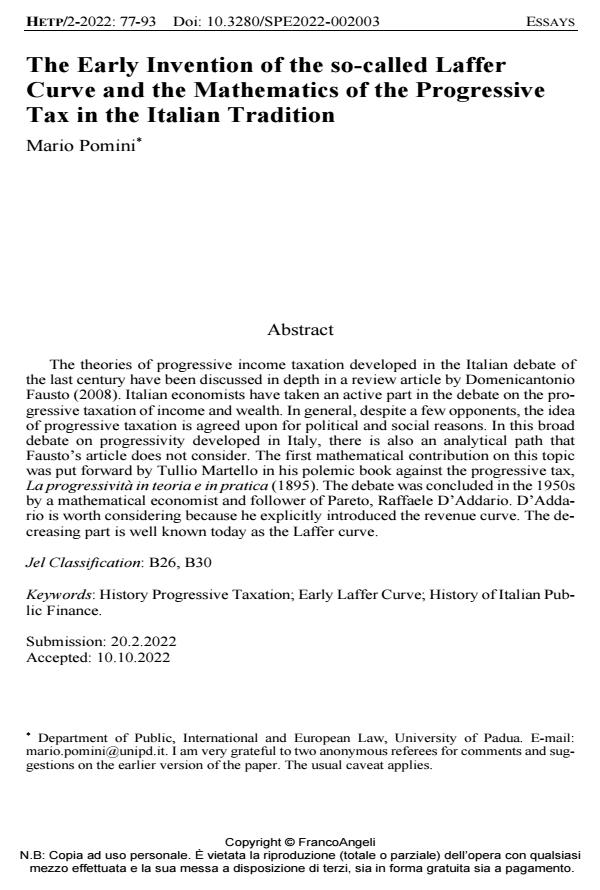The Early Invention of the so-called Laffer Curve and the Mathematics of the Progressive Tax in the Italian Tradition
Titolo Rivista HISTORY OF ECONOMIC THOUGHT AND POLICY
Autori/Curatori Mario Pomini
Anno di pubblicazione 2022 Fascicolo 2022/2
Lingua Inglese Numero pagine 17 P. 77-93 Dimensione file 121 KB
DOI 10.3280/SPE2022-002003
Il DOI è il codice a barre della proprietà intellettuale: per saperne di più
clicca qui
Qui sotto puoi vedere in anteprima la prima pagina di questo articolo.
Se questo articolo ti interessa, lo puoi acquistare (e scaricare in formato pdf) seguendo le facili indicazioni per acquistare il download credit. Acquista Download Credits per scaricare questo Articolo in formato PDF

FrancoAngeli è membro della Publishers International Linking Association, Inc (PILA)associazione indipendente e non profit per facilitare (attraverso i servizi tecnologici implementati da CrossRef.org) l’accesso degli studiosi ai contenuti digitali nelle pubblicazioni professionali e scientifiche
The theories of progressive income taxation developed in the Italian debate of the last century have been discussed in depth in a review article by Domenican-tonio Fausto (2008). Italian economists have taken an active part in the debate on the progressive taxation of income and wealth. In general, despite a few oppo-nents, the idea of progressive taxation is agreed upon for political and social rea-sons. In this broad debate on progressivity developed in Italy, there is also an ana-lytical path that Fausto’s article does not consider. The first mathematical contri-bution on this topic was put forward by Tullio Martello in his polemic book against the progressive tax, La progressività in teoria e in pratica (1895). The debate was concluded in the 1950s by a mathematical economist and follower of Pareto, Raf-faele D’Addario. D’Addario is worth considering because he explicitly introduced the revenue curve. The decreasing part is well known today as the Laffer curve.
Parole chiave:History Progressive Taxation; Early Laffer Curve; History of Italian Public Finance.
Jel codes:B26, B30
- Conigliani C. (1903). Saggi di Economia Politica e Scienza delle Finanze. Torino, Fratelli Bocca, pp. 581-617.
- D’Addario R. (1950a). Sulle proprietà dell’equazione rappresentatrice dell’aliquota di una imposta progressiva. Archivio Finanziario. Padova, Cedam, 83-93.
- D’Addario R. (1950b). Sulla misura della progressività strutturale di una imposta, Giornale degli Economisti e Annali di Economia, 9: 578-628.
- D’Addario R. (1962), Sulla costruzione della scala delle aliquote di una imposta progressive, Giornale degli Economisti e Annali di Economia, 21: 155-171.
- Da Empoli D. (2003). Equity issues in the Italian public finance tradition, Il Pensiero Economico Italiano, XI: 159-167.
- Dallera G. (2003). The Italian tradition in fiscal theory: taxation and efficiency, Il Pensiero Economico Italiano, XI: 122-158.
- De Viti de Marco A. (1928). Principi di economia finanziaria. Torino, Einaudi.
- Einaudi L. (1948). Principi di Scienza delle Finanze. Torino, Boringhieri.
- Fausto D. (1982). Il dibattito sull’imposta progressiva, Gli italiani e Bentham, in R. Faucci (ed.), 105-131.
- Fausto D. (2008). The Italian theories of progressive taxation, The European Journal of the History of Economic Thought, 15(2): 293-315.
- Flora F. (1921). Manuale di Scienza delle Finanze. Milano, Raffaello Cortina Editore.
- Fossati A. (2003). Public goods in the Italian tradition, Il Pensiero Economico Italiano, XI: 99-123.
- Fossati A. (2010). The idea of State in the Italian tradition of public finance, European Journal of the History of Economic thought, 17:(4): 881-907.
- Gobbi U. (1934) [1897]. Sul carattere razionale dell’imposta progressiva, in Scritti varii di economia. Milano: Giuffrè, 289-299.
- Gobb U. (1934) [1899], Un teorema elementare sulla relazione tra imposta e ricchezza, in Scritti varii di economia. Milano: Giuffrè, 299-302.
- Graziani A. (1911). Istituzioni di scienza delle finanze. Padova: Cedam.
- Martello T. (1895). L’imposta progressiva. Torino: Unione Tipografica Editrice.
- Masè-Dari E. (1897). L’imposta progressiva. Indagini di storia e di economia della finanza. Torino: Fratelli Bocca Editore.
- Middleton R. (2010). The Laffer Curve, Famous Figures and Diagrams in Economics, M. Blaug and P. Lloyd (eds.), Cheltenham: Edward Elgar.
- Paladini R., and A. Rinaldi Baccelli (2008), From Necessaries and Superfluities to the Utility Function: The Problem of Distribution in the History of Economic Thought, Theory and Practice of Economic Policy: Tradition and Change, P. Bini and G. Tusset, eds., Milano: FrancoAngeli.
- Rossi L. (1933). Sull’imposta progressiva. Firenze: Libreria Internazionale Seeber.
- Rossi L. (1957). Corso di Scienze delle Finanze e Diritto Finanziario. Padova: Editrice Milani.
Mario Pomini, The Early Invention of the so-called Laffer Curve and the Mathematics of the Progressive Tax in the Italian Tradition in "HISTORY OF ECONOMIC THOUGHT AND POLICY" 2/2022, pp 77-93, DOI: 10.3280/SPE2022-002003